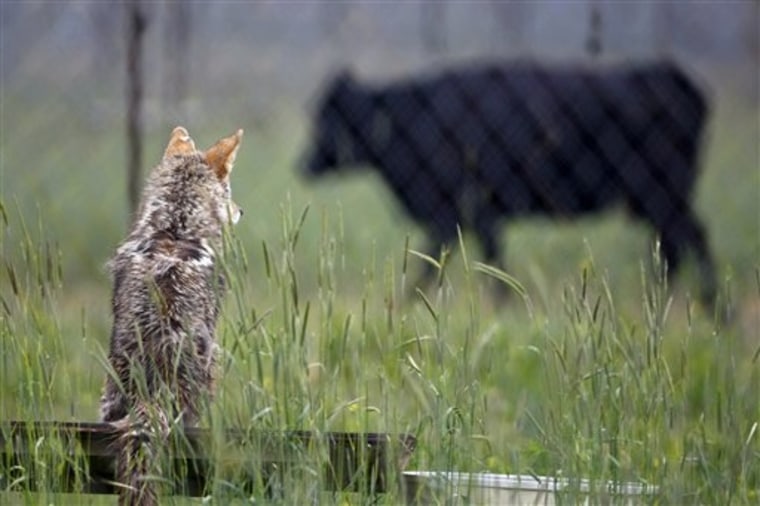Coyotes are often unwelcome guests, whether they're prowling city parks, stalking the prairies or roaming the modern American suburb. Usually they forage for food, snarf down a rodent or two and disappear into the night.
Each year, U.S. government agents shoot, trap and poison about 90,000 of the ones suspected of killing livestock or causing other problems. But they're still trying to figure out how to turn the less troublesome coyotes back from neighborhoods and ranches — without killing them.
Researchers in Utah, Chicago and elsewhere have tried a number of methods — from startling noises and lights to the whiff of wolf urine and electrified fencing. They have discovered a stubborn truism about coyotes: Unlike the bumbling cartoon character, they are wily.
"We're really interested in how they outsmart us," said John Shivik, who runs the nation's only large-scale coyote research center near Utah State University.
Coyotes are fast-learners. They share information with each other and can overcome fears quickly when they realize that something that looks or sounds dangerous actually isn't. They're also fiercely individualistic, so a technique that works on one coyote might not work on another.
"There is no single solution for coyotes," said Stan Gehrt, an assistant professor at Ohio State University who has been studying urban coyotes in Chicago since 2000.
Nonlethal approaches
Wildlife Services — the federal agency that's spending about $16 million this year to protect livestock from wild animals — is transitioning toward a more nonlethal approach with coyotes, said Gail Keirn, an agency spokeswoman in Fort Collins, Colorado.
No one's talking about eliminating programs to kill coyotes. But over the years, there's been an acknowledgment of the importance of keeping some of the predators on the landscape and dealing primarily with those causing damage.
"We're not out there to eradicate the coyotes. They're an important part of the ecosystem," Keirn said.
For generations, coyotes were viewed as vermin — four-legged thieves that showed up in the night to steal livestock and howl eerily in the darkness. Coyotes remain the top culprit in predator-caused deaths — though far from the overall leading cause of death — among sheep and cattle.
More than 135,000 sheep valued at more than $10 million were killed by coyotes in the U.S. in 2004, the latest figures available from the National Agricultural Statistics Service. Coyotes killed about 97,000 in 2005, a loss estimated at $44 million, according to the agency.
Of the coyotes targeted last year by Wildlife Services, more than 11,000 died from M-44s, a tube-shape capsule with a pellet of sodium cyanide inside. Conservation groups have petitioned the Environmental Protection Agency to have it banned.
"I just think the whole system of predator control needs enormous rethinking," said Wendy Keefover-Ring of WildEarth Guardians.
In Gehrt's Chicago study — the largest of its kind on an urban coyote population in the United States — researchers found that some harassment devices worked, including two instances where wolf urine was successful keeping coyotes out of a yard. Wolves were at one time natural enemies of the coyotes.
The researchers at other times used a more low-tech method: groups of volunteers chasing coyotes while shaking coffee cans full of coins.
Researchers know less about city coyotes than rural ones, primarily because they're relatively new on the scene. Few cities had any coyotes to speak of in the late 1980s. Now, they're in most metropolitan areas across the country, Gehrt said.
About 300 have been radio-collared and tracked in Chicago. For the most part, they stay out of trouble — apparently feeding more often on rodents, deer and rabbits than family pets. Those that do pose problems may need tailor-made solutions.
"Some of the things, like sirens, might work out on the range but not as well in the city, for obvious reasons," Gehrt said.
Unpredictable
At the Utah research center — which focuses primarily on conflicts between livestock and predators — 165 acres are ringed with high fences and outfitted with a high-tech security system.
Inside, about 100 coyotes are kept busy testing the latest nonlethal devices and techniques. Those that pass muster in this outdoor laboratory are taken into the field — often to ranches where coyotes have been a problem.
One of the items is a suitcase-shaped device with a flashing light and noise system that blurts out sounds of bowling alleys, car crashes and people yelling. Some bolder coyotes simply ignored the device, others stayed away and a third group were frightened at first but eventually overcame their fears.
"Coyotes just aren't that predictable," Shivik said. "That's what makes this so hard."
Other experiments have focused on "conditioned flavor avoidance" — something akin to smelling tequila the morning after a bender — and electrified strips of red flagging that provides a brief jolt for unsuspecting animals.
Researchers in homemade perches overlooking large enclosures spend days, weeks or longer watching coyotes, looking for any helpful hints about how their minds work and how they translate knowledge into behavior.
Ultimately, the solution to keeping coyotes out of trouble will be a complicated one, Shivik said. Sometimes it will require a mix of lethal and nonlethal methods that change over time. Landowners and wildlife managers will have to be flexible but, in the end, coyotes and people should be able to get along.
"We're trying to help coyotes as much as we help people," Shivik said.
